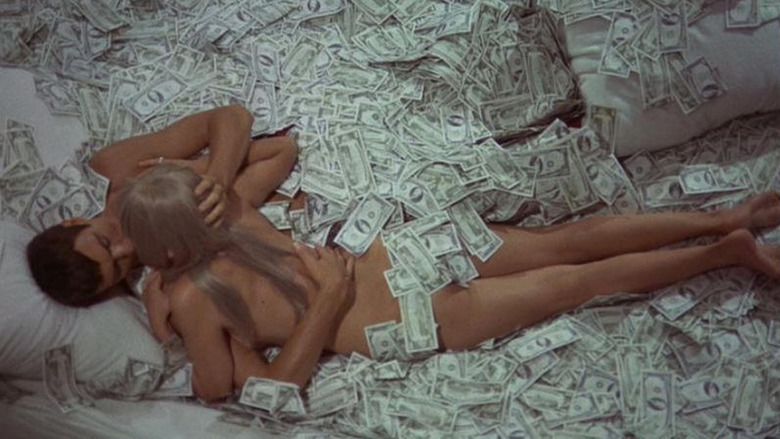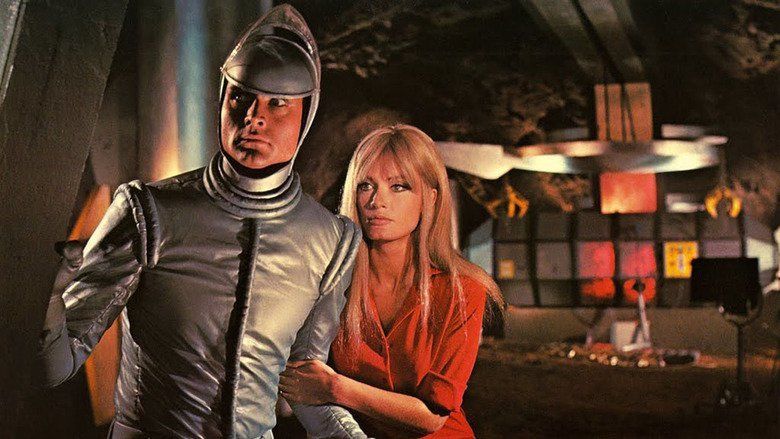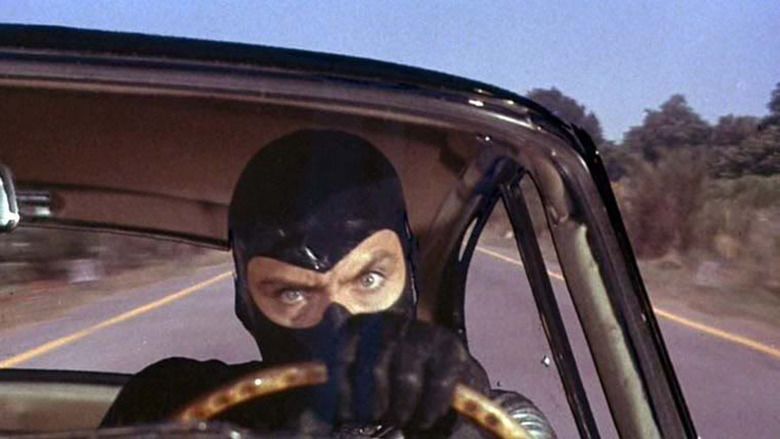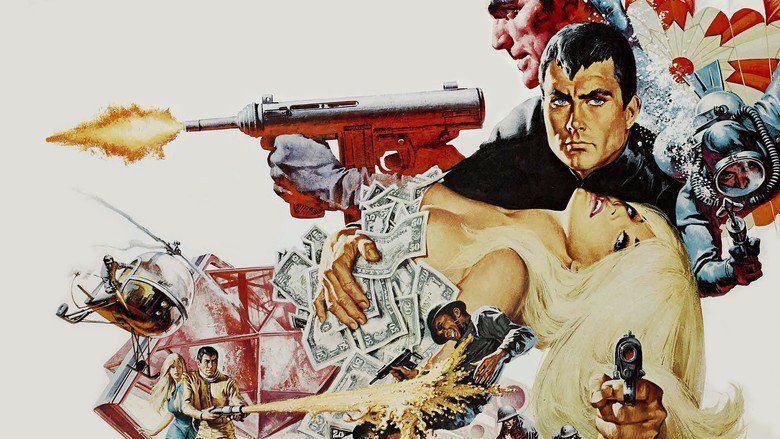Danger: Diabolik
6.4 /10 1 Votes
67% Rotten Tomatoes Initial DVD release June 14, 2005 Duration | 6.5/10 IMDb 2.5/4 Roger Ebert Genre Action, Comedy, Crime Country ItalyFrance | |||||||||||||||||||||||||||||||||
 | ||||||||||||||||||||||||||||||||||
Release date January 24, 1968 (1968-01-24) (Italy) Writer Angela Giussani (story), Luciana Giussani (story), Arduino Maiuri (story), Adriano Baracco (story), Arduino Maiuri (screenplay), Brian Degas (screenplay), Tudor Gates (screenplay), Mario Bava (screenplay) Cast Similar movies X-Men , X2: X-Men United , X-Men: The Last Stand , X-Men: Apocalypse , X-Men: Days of Future Past , The Wolverine Tagline Out for all he can take, seduce, or get away with... | ||||||||||||||||||||||||||||||||||
Danger diabolik 1968 hq
Danger: Diabolik (Italian: Diabolik) is a 1968 action film directed and co-written by Mario Bava, based on the Italian comic series Diabolik by Angela and Luciana Giussani. The film is about a criminal named Diabolik (John Phillip Law), who plans large-scale heists for his girlfriend Eva Kant (Marisa Mell). Diabolik is pursued by Inspector Ginko (Michel Piccoli), who blackmails the gangster Ralph Valmont (Adolfo Celi) into catching Diabolik for him.
Contents
- Danger diabolik 1968 hq
- Plot
- Development
- Pre production
- Production
- Release
- Reception
- Aftermath and influence
- Danger diabolik 1968 review
- References

An adaptation of the comics was originally envisioned by producer Tonino Cervi. Cervi hired director Seth Holt and began producing the film as an international co-production, with a cast that included Jean Sorel, Elsa Martinelli and Gilbert Roland. After producer Dino De Laurentiis saw the footage that had been shot, he halted production on the film, had a new screenplay developed, and hired a new director and cast. This resulted in Bava directing the film on a much lower budget, with more well-known actors taking smaller roles. Many of the cast and crew members were brought in from Barbarella, De Laurentiis' other comic book adaptation of that year.

Upon its theatrical release, Danger: Diabolik performed below De Laurentiis' expectations at the box office, and received negative reviews from The New York Times and Variety. With the re-evaluation of Bava's filmography, contemporary reception of the film has been more positive, with critics praising its visuals, the performances of Law and Mell, and the score by Ennio Morricone. Two new adaptations of Diabolik were announced in the 2000s, but neither went into production.

Plot

After an armored car leaves a bank with ten million dollars, it is attacked en route by Diabolik who manages to steal the money and escape with his partner Eva Kant. Leaving the money in their underground hideout, Diabolik and Eva attend a press conference held by the Minister of the Interior which they disrupt by releasing laughing gas. Due to the high level of crime, the death penalty is brought back. The police cannot find Diabolik, and gang leader Valmont suffers at their hands from a clampdown because of his actions. Realising things can only get worse because of Diabolik's crime spree, Valmont contacts Inspector Ginko and makes a deal to catch him for the police. At his hideout, Diabolik decides to steal the famous Aksand emerald necklace from the Saint Just Castle for Eva's birthday. Valmont builds up an identikit picture of Eva and circulates it as a means of capturing Diabolik. Diabolik scales the walls of Saint Just Castle where he finds the police lying in wait. He manages to steal the necklace by fooling the police officers with mirrors on the road and dummy decoys of himself.

Valmont has one of his henchmen kidnap Eva. To rescue her, Diabolik boards Valmont's airplane with the ten million dollars and the emerald necklace to trade for Eva. He is ejected from the plane but manages to grab Valmont just before a bomb he had placed earlier explodes. Diabolik rescues Eva as the police close in on them. Eva makes her escape while Diabolik battles and kills Valmont. Diabolik takes a capsule and appears to have died while being taken to the hospital by the police. As police hold a press conference about Diabolik's death, he is about to be autopsied when he returns to life. Diabolik reveals that he has faked his death using a technique taught him by Tibetan lamas.
Posing as a nurse, Eva wheels Diabolik past groups of people. He sneaks into the morgue where Valmont's body has been cremated, collects the eleven emeralds from his ashes and escapes. The police discover that Diabolik is still alive and offer a million-dollar reward for him. He reacts by blowing up the tax offices. Without tax revenue, the country is in debt and sells off some gold to buy currency. Twenty tons of gold is melted into one solid block to make it difficult to steal, and the block is loaded on a train. Diabolik and Eva divert the train by leaving a burning truck on the tracks and re-route it to a bridge where a bomb is placed. It explodes when the train arrives and the gold falls into the water below. Diabolik and Eva collect it and return it to their hideout.
The steel casket containing the gold is traced by the police allowing them to track down Diabolik's hideout. They close in on Diabolik, who is melting the gold and turning it into ingots. Because the police are shooting at him, Diabolik is unable to control the heating of the gold, and the whole cavern ends up being covered in molten gold. Again, Diabolik is believed to be dead, with his heat-proof suit now covered in solidified gold. The police seal off the cavern intending to recover the gold later. Eva is allowed to pay her respects to Diabolik, who winks at her.
Development
Producer Tonino Cervi, head of the production company Italy Film, was the first person to propose a film adaptation of the Diabolik comic strip. During this period, Andre Hunebelle's film Fantomas was popular. Cervi was ambiguous when describing his production, stating once that "I think that with a few retouches [Diabolik] could turn into an extraordinary character for the silver screen." In another interview, he acknowledged that "nowadays a good film based on Flash Gordon would be a sensational success [...] but it would cost as much as Cleopatra. I have to settle for something more modest, so I'm doing Diabolik." Cervi's initial intention was that Diabolik would allow him to finance an anthology film directed by Federico Fellini, Ingmar Bergman, and Akira Kurosawa.
Italy Film acquired the rights from Diabolik's publisher Astorina for 20 million lire, and proposed a distribution deal with Dino De Laurentiis. This deal would involve 100 million lire in advance, in exchange for the distribution rights for the film in perpetuity. De Laurentiis advanced 70 million lire, and put together a co-production deal between Italy, France (Les Films Marceau-Cocinor), and Spain (A.S. Film Produccion and Impala). The first drafts of the film were written by comic book writers Pier Carpi and Corrado Farina, who also worked in television advertising. These drafts were later revised by screenwriters Giampiero Bona and Fabrizio Onofri, who were told to tone down the violence. Onofri and Bona's screenplay also added an emphasis on comedy that was present in the Fantomas films. The film was initially going to be shot by British director Seth Holt, with French actor Jean Sorel chosen to play Diabolik. Other roles included Elsa Martinelli as Eva Kant and George Raft as Diabolik's enemy, Richness. Principal photography began on September 20, 1965, in Malaga, Spain, but halted when Raft became sick on set and was replaced with Gilbert Roland. The film finished shooting on November 13. After viewing Holt's footage, De Laurentiis temporarily aborted the film's production, stating that the footage shot "was of a level so low, both from an artistic and commercial point of view, as to make us clearly understand that to continue on that path meant heading toward disaster."
Pre-production
De Laurentiis felt the only way to save the production was to find a new director and have the script rewritten. The other production companies were not content with De Laurentiis stopping production, which led Les Films Marceau-Cocinor to terminate its contract with Italy Film. A.S. Film Produccion confiscated the footage and took cameras, costumes, and weapons that had been rented by Italy Film, which nearly bankrupted the company. De Laurentiis restarted production with financial backing from distributor Paramount Pictures, and hired Mario Bava as director. The budget was also cut to 200 million lire, less than half of the original budget.
Changes in the budget led to established actors being cast in smaller roles, including Adolfo Celi as the villain Valmont and Michel Piccoli as Ginko. John Philip Law was cast as Diabolik as a favour by De Laurentiis after production on Barbarella, which Law was acting in, was postponed due to technical difficulties. Law was initially unfamiliar with the characters in either Barbarella and Diabolik, and read the comic books to understand the characters. Initially, the role of Eva Kant was going to be played by an unidentified American model, but she was fired before shooting began.
The script for Danger: Diabolik was written by Dino Maiuri, Tudor Gates, Brian Degas, and Bava. The screenplay was adapted from three different Diabolik stories: Sepolto vivo! ("Buried Alive!") from August 1963, Lotta disperata ("Desperate Fight") from March 1964, and L'ombra nella notte ("Shadow In The Night") from May 1965. Like Law, Degas and Gates had also worked on Barbarellla. Film editor Romana Fortini and cinematographer Antonio Rinaldi were also brought in, having worked with Bava on his previous films such as Planet of the Vampires and Kill, Baby, Kill. Other crew members included future Academy Award winners, such as set designer Carlo Rambaldi (E.T. the Extra-Terrestrial) and composer Ennio Morricone (The Hateful Eight).
Production
Danger: Diabolik began filming on April 11, 1967. Roger Vadim suggested to De Laurentiis that he cast his ex-fiancée Catherine Deneuve as Eva Kant. Law noted that Bava was against this idea and felt personally that Deneuve was wrong for the role, noting that "there was no chemistry between us. She was very sweet, and a very good actress, but she was simply not right for the part." After one week of shooting with Deneuve, both Bava and De Laurentiis felt that she should be replaced. Bava was given the opportunity to cast the role, and narrowed his choices to Marilù Tolo and Marisa Mell, with Mell eventually getting the role.
The film was shot at a Fiat plant in Turin, on location in Rome, and at the Blue Grotto in Capri. In a 1970 interview with Luigi Cozzi, Bava described the filming as "nightmarish", and said that De Laurentiis had him tone down the violent scenes in the film. Actor John Phillip Law commented that both the producer and director had opposite ideas for the film. De Laurentiis wanted to make a family-friendly film with a charming thief, while Bava wanted to make a film that was closer to the original comic book series. Danger: Diabolik finished filming on June 18, 1967. Law stated that shortly after the film's production ended, shooting began on Barbarella. This led to the same sets, such as the set for Valmont's night club, being used in both films.
Release
Danger: Diabolik's release was highly anticipated in Italy, and this led to De Laurentiis threatening to sue producers of films whose titles were similar to his, such as Superargo Versus Diabolicus and Arriva Dorellik. Danger: Diabolik was submitted to the Italian Board of Censors in December 1967 and, after five brief cuts were made to the film, it was released in Italy on January 24, 1968. The film was described by Curti as a "financial disappointment for De Laurentiis" with a gross of only slightly more than 265 million lire. It opened in Paris in April 1968 under the title Danger Diabolik. In the United States, the film opened in New York in December 1968.
Danger: Diabolik was released on DVD by Paramount Pictures on June 14, 2005. The DVD includes an audio commentary by John Phillip Law and Mario Bava biographer Tim Lucas, as well as the music video for "Body Movin'" by the hip-hop group the Beastie Boys. Reviews of the disc by Cinefantastique, DVD Talk and Video Librarian praised the release, noting a high-quality digital transfer and the plethora of extra features. The DVD is now out of print.
Two English-language dubs of Danger: Diabolik were produced, both featuring the voices of Law, Mell and Terry-Thomas. The original English version, used for the film's theatrical and DVD release, presented the remaining cast dubbed with predominantly British accents. The second version, used for the film's VHS and LaserDisc release (as well as its showing on Mystery Science Theater 3000), was created when the original sound elements for the dubbed version (aside from those of the three aforementioned performers) were believed to be lost; the non-English-speaking actors were dubbed with American accents. This version also greatly remixed the audio levels for the sound effects and music, and dropped the Danger: from the original English version's title due to using an Italian print. The audio masters for the original English version were eventually recovered by Kim Aubry of American Zoetrope, who produced Paramount's DVD release.
Reception
From contemporary reviews, Howard Thompson of The New York Times gave a brief negative review of Danger: Diabolik referring to the film as "infantile junk." Film critic Roger Ebert gave the film a two and a half star rating out of four, stating that he felt it was better than the other Dino De Laurentiis production Barbarella, but that it was "long and eventually loses track of itself." Variety gave the film a negative review, calling it a "dull Dino De Laurentiis programmer" whose "[b]izarre sets, poor process work, static writing and limp direction spell pure formula fare for lowercase grind bookings." The Monthly Film Bulletin gave the film a positive review, noting that: "Bava's superb visual sense stands him in good stead in this comic-strip adventure which looks like a brilliant pastiche of the best of everything in anything from James Bond to Matt Helm."
In a 2012 issue of Film International, John Berra described the film's contemporary reception, noting that the film had initially "been left to languish in obscurity since its staggered international release at the end of the 1960s" and that it "mostly existed as a kitsch reference point or as an easy target for tongue-in-cheek parody." Examples of this are seen in the Beastie Boys music video for "Body Movin'" (1998) and the film being featured on the final episode of Mystery Science Theater 3000 shown on Sci-Fi Channel on August 8, 1999. The television show provided mocking commentary over a film interspersed with sketches while Beastie Boys member Adam Yauch found the film to be "campy in a way, but not in a bad way" and describes the acting and direction as "ridiculous" but with the set design being "so over the top the acting is appropriate." The film's status as a cult film grew gradually as studies of Bava's career began, and with its 2007 DVD release which explored the film's relation to its comic book roots. Berra described the film as being "warmly received" by the Internet community, who routinely embraces comic book adaptations and seeks to adopt films that have been neglected by popular audiences.
Glenn Erickson discussed Danger: Diabolik twice on DVD Talk (in 1998 and 2005); describing the film as a guilty pleasure, he praised Bava's stylized visuals, noting his use of bright colours, elaborate sets and wide lenses, "giving almost every shot a distorted depth that lends the film a consistent comic book dynamism". While noting the minimal characterization of Diabolik himself (describing him as "the final distillation of the idea that we love criminals because we secretly admire the transgressions they represent"), he felt that Marisa Mell's portrayal of Eva presented her as loving Diabolik "on a romantic plane of surprising believability. [...] [Her] adoring faithfulness is so physical and pure that the sincerity of their farewell ("You'll not be alone while I live!") is tenderly affecting." Erickson also admired Terry-Thomas' campy portrayal of the Minister of Interior, describing his news conference as "easily outdo[ing] TV's Batman." Thematically, he has noted that Diabolik's desire to steal for himself and Eva "represent[s] the ultimate end of materialist consumerism", as well as "the rollercoaster Italian politics of the time, which seemed to flip-flop from conservative to socialist and back again on a weekly basis;" Erickson also mentions that "Diabolik's world stresses strangely fetishistic surfaces and textures, backing up film theorist Raymond Durgnat's assertion that the psychic land of pulp fantasy is fundamentally a sexual one."
Video Librarian noted that the film was "guaranteed to delight viewers whose tastes run to the outré", praising Ennio Morricone's score, Law and Mell's acting, and noting that the "real star is Bava" stating that "the film is colorful almost to the point of garishness." Cinefantastique also discussed the film's visuals, noting that: "[Bava's] color rich, brilliantly artificial-looking compositions were the cinematic equivalent of comic book art even before he tackled the form." The magazine also found that the special effects rivalled those of Ken Adam, who worked on the Bond films. The review also praised Law's work in the film noting his "amazingly expressive eyebrows" and declared the film as "1960s pop-culture heaven." Ignatiy Vishnevetsky (The A.V. Club) compared the film to Barbarella, opining that Diabolik had "a sense of infectious, amoral fun" which Barbarella lacks. He declared the film to be among "the definitive touchstones of Euro pulp." Empire included the film on its list of the top 500 greatest films. They described the movie as "thin as a poster, but still amazing cinema – a succession of striking, kinetic, sexy, absurd images accompanied by a one-of-a-kind Ennio Morricone score that revels in its casual anarchy."
Aftermath and influence
The release of Barbarella and Danger: Diabolik led to a minor trend of film adaptations of comic strips that emphasized mild sadomasochism and late 1960s fetish gear. Diabolik was the first of three European comic strip adaptations released in 1968, the other two being Piero Vivarelli's Satanik and Roger Vadim's Barbarella. These films were followed by Bruno Corbucci's Ms. Stiletto and Corrado Farina's Baba Yaga (1973). The look of Diabolik influenced the comic series. The film's audiences could see Diabolik's mouth because Law's mask was made of latex. This resulted in the comic's artists Enzo Facciolo and Sergio Zaniboni giving up on trying to shade in his mouth and simply outlining it.
In the early 2000s, a new feature film based on the Diabolik comics to be directed by Christophe Gans and starring Mark Dacascos and Monica Bellucci was in the planning stages. Gans opined that: "The Bava film is unique and I'd never, ever want to copy it. But let's see where we can take Diabolik today for a totally new and different Pop art experience." The film has not gone into production. In 2002, screenwriter Mario Gomboli announced a French production of Diabolik was to be made with a contemporary setting and a script written by Carlo Lucarelli and Giampiero Rigosi. A script was completed in April 2007, with filming set to begin in January 2008, but the production stalled.
British director Edgar Wright cited Danger: Diabolik as an influence on his film Scott Pilgrim vs. the World, describing it as an "Italian influence, a sense of completely unbridled imagination. They don't make any attempt to make it look realistic. Mario Bava's composition and staging has a real try-anything attitude."
Danger diabolik 1968 review
References
Danger: Diabolik WikipediaDanger: Diabolik IMDbDanger: Diabolik Rotten TomatoesDanger: Diabolik Roger EbertDanger: Diabolik themoviedb.org
